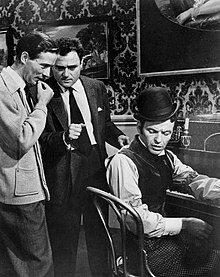Production
| This section needs additional citations for verification. (October 2012) (Learn how and when to remove this template message) |
Michael Anderson, Michael Todd and Frank Sinatra on set
In the autobiographical book The Moon's a Balloon, published in 1972, the actor David Niven discussed his meeting with Todd and the subsequent events that led to the film being produced. According to Niven, when Todd asked him if he would appear as Fogg, Niven enthusiastically replied, 'I'd do it for nothing!' He later admitted to being grateful that Todd did not hold him to his claim. He also described the first meeting between Todd and Robert Newton (who suffered from drinking problems) when the latter was offered the role of the detective, Fix; Niven alleged that Newton was offered the part on condition that he did not drink any alcohol during the filming, and that his celebration following the completion of his role led to his untimely demise (he did not live to see the film released).
Filming took place in late 1955, from August 9 to December 20.[citation needed] The crew worked fast (75 actual days of filming), producing 680,000 feet (210,000 m) of film, which was edited down to 25,734 feet (7,844 m) of finished film. The picture cost just under $6 million to make,[citation needed] employing 112 locations in 13 countries and 140 sets.[1] Todd said he and the crew visited every country portrayed in the picture, including England, France, India, Spain, Thailand and Japan.[citation needed] According to the Time magazine review of the film,[1] the cast including extras totalled 68,894 people; it also featured 7,959 animals, "including four ostriches, six skunks, 15 elephants, 17 fighting bulls, 512 rhesus monkeys, 800 horses, 950 burros, 2,448 American buffalo, 3,800 Rocky Mountain sheep and a sacred cow that eats flowers on cue." There is also a cat, at the Reform Club. The wardrobe department spent $410,000 to provide 74,685 costumes and 36,092 trinkets.[1]
The main square of Chinchón arranged as a bullring
|
Todd sometimes used models of boats, ships and trains in the film, but he often decided that they didn't look realistic so he switched to the real thing where he could. The scene of a collapsing train bridge is partly without models. The overhead shot of a train crossing a bridge was full scale, but the bridge collapse was a large-scale miniature, verifiable by observing the slightly jerky motion of the rear passenger car as the train pulls away, as well as the slowed-down water droplets which are out of scale in the splashing river below. All the steamships shown in the first half are miniatures shot in an outdoor studio tank. The exception is the American ship shown at the intermission point, which is real. A tunnel was built for a train sequence out of paper mache. After the train filming was complete, the "tunnel" was pushed over into the gorge.
The scenes of the crossing of the Atlantic Ocean by steamship took place off San Francisco and were shot on a specially built prop steamer, a converted barge mocked up to resemble a small ocean-going steamship, with mock paddles driven by the electric motor from an old streetcar. In his memoirs, Niven described the whole thing as being dangerously unstable (though stability improved as it was dismantled as though to feed it into its own furnaces as the plot required).
One of the most famous sequences in the film, the flight by hydrogen balloon, is not in the original Jules Verne novel. Because the film was made in Todd AO, the sequence was expressly created to show off the locations seen on the flight, as projected on the giant curved screen used for the process. A similar balloon flight can be found in an earlier Jules Verne novel, Five Weeks in a Balloon, in which the protagonists explore Africa from a hydrogen balloon.[11]


No comments:
Post a Comment